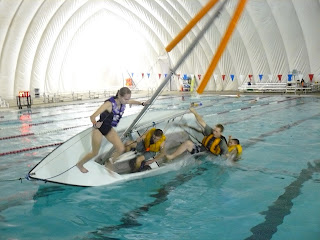
Here is how it starts: bringing an FJ to the Twin Rivers YMCA pool.
The coaches get everything ready.
.

Then the class shows up
.

This time of year, the pool is covered by a "bubble" roof.
We have to carry the boat in through a door.
.

To fit in thru the door, the FJ hull is tipped on it's side, and one group of cadets hands it in to another group waiting inside.
.

Now we have to put up the mast & rig the boat. What are the names of all these parts, again?
.

Now we're all ready! Who is going to go first?
We have a few advanced sailors in the class this spring, and they actually run the drill.
.

No wind inside the "bubble" so no sails. However, the skipper & crew (beginner sailors) are in position.
In the water, an advanced sailor swims the boat into position. Another advanced sailor cadet is on the foredeck ready to pull the boat into a capsize
.
Into the water!
FJs get very unstable when a person is standing on the foredeck, so this part is easy.
.
You never know how people will react when suddenly dumped into deep water. One big reason to practice is so that if it happens in real life the shock effect will be much less.
.

Step 1- make sure all persons on board are OK
.

Step 2- get control of the boat
This means one person (usually the skipper) holds the centerboard to ensure the boat does not turn completely over (turtled).
.

The crew has a job also, tossing the bow line (painter) over the gunwhale to give the skipper greater leverage, to ensure the sheets are not tangled and the sails free, and to "scoop" into the boat as it comes upright.
.

Step 3- the boat is upright, the crew is on board, help the skipper in and sail away!
.
Everybody in the sailing class got their chance to show they have learned the CAPSIZE DRILL
.
Then, as always, there is work to do. We put everything away properly, being 'squared away' is one of the marks of a real sailor.
In this case, the first step is to drain the water out of the boat!
Next week, we hope to show what we've learned about rigging and sailing... everybody remember TACKING? ... but hopefully not capsizing because the river is still cold water.
... posted by Assistant Coach Douglas King
.









